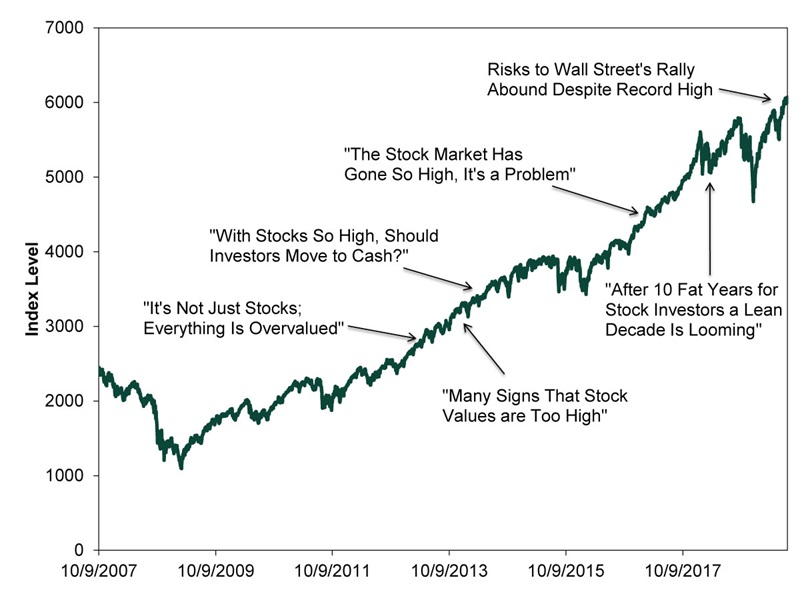Personal Wealth Management /
What to Make of Stock Market Milestones
Not much, except that sentiment still appears pretty blah.
Recent record highs and round numbers reached in the S&P 500 and Dow Jones Industrial Average (aka the Dow) have garnered many headlines of late. The Dow topped 27,000 on July 11; the S&P 500 price index breached 3000 the next day.[i] The latter notched a record high on Wednesday—and stands at another intraday as we type this Friday.[ii] But in our view, all these “milestones” reveal nothing about where stocks are headed. However, we think popular reactions to those highs hint at more bull market ahead.
The primary reason we see financial pundits' hyping of market milestones as mostly a waste of pixels: Stock market records aren’t predictive. They are simply a derivative of past price movement, and stock prices aren’t serially correlated—meaning, past price movement says nothing about future. This is an iron rule. It doesn’t bend when prices reach some arbitrary marker, like a round number or record.
Fear of heights isn’t just misguided—in our view, it is often dangerous for investors. This mentality encourages seeking safety in cash or bonds at a time when lots of bull market may remain—and that remainder may hold gains long-term investors seeking to earn equity-like returns need. Heeding fearful “Record High, Oh Dear” headlines like those in Exhibit 1 can be costly. Consider: The S&P 500 has notched 291 record highs during this bull market through July 24. An investor who exited stocks at the 150th top, on May 15, 2015, would have foregone 55.0% gains since.[iii] Ouch!
Exhibit 1: S&P 500 Record Highs & Headlines
Source: FactSet, as of 7/26/2019. S&P 500 Total Return Index, 10/9/2007 – 7/24/2019. source, source, source, source, source, source.
Recent milestones attracted plenty of coverage, much of it containing cautionary notes.
- “Near-term threats that could send stocks tanking, like they did in July 1998, include a further breakdown in the U.S.-China trade war and a more severe economic slowdown.”[iv] (Note: 1998’s “wild” second-half was tied to a correction that came and went fast, with US stocks finishing the year up 28.6%.)[v]
- “There’s a creeping concern about the slowing of both the global and domestic economy, just as companies are set to post their first profit decline since 2016.”[vi] (Note: US stocks rose 12.0% in 2016 and were up more in 2017.[vii])
- “The stock market is climbing even though there’s plenty to worry about. Any of the following could arguably derail the decade-long economic expansion and the rally: the seemingly never-ending trade war between China and the United States, a slowing global economy and simmering geopolitical tensions that could escalate into a full-blown conflict.”[viii]
We think all these alleged risks are some combination of exaggerated and widely covered. But more importantly, the fact so much coverage of new heights hypes potential risks suggests investor sentiment is miles from the euphoria that often typifies market peaks. Equity fund outflows and big bond fund inflows echo this. Consider legendary investor Sir John Templeton’s depiction of investor sentiment’s evolution during a market cycle: “Bull markets are born on pessimism, grow on skepticism, mature on optimism and die on euphoria.” That is what we in the biz call climbing the “wall of worry.”
Is it possible that at some point, market records or milestones foster overheating sentiment, setting stocks up for a fall? Sure! But even here, the popular reaction to stock price markers represents just a piece of overall investor sentiment. Presently, we mostly see evidence of pervasive skepticism towards rising markets, not a broad attitude of, “break out the champagne so we can celebrate these new highs, hurrah!” Citing risks and allegedly soon-to-fade “catalysts” is a textbook brick in the wall. In our view, this suggests there is lots of wall left to climb—likely helping this bull market march along for the foreseeable future.
[i] “First Dow 27,000, now S&P 3,000, as U.S. stocks march ever higher,” Staff, AP, 7/12/2019. https://www.cbsnews.com/news/stock-market-today-record-s-p-3000-as-u-s-stocks-rise-on-interest-rate-optimism/
[ii] Source: Factset, as of 7/26/2019. S&P 500 Total Return Index, 7/24/2019 and 7/26/2019.
[iii] Ibid. S&P 500 Total Return Index, 5/15/2015 – 7/24/2019.
[iv] “The last time the S&P 500 looked like this, it had a wild rest of the year,” Maggie Fitzgerald, CNBC, 7/17/2019. https://www.cnbc.com/2019/07/16/the-last-time-the-sp-500-looked-like-this-it-had-a-wild-rest-of-the-year.html
[v] Source: FactSet, as of 7/26/2019. S&P 500 Total Return, 12/31/1997 – 12/31/1998.
[vi] “Stock Investors Go ‘All-In' With $6 Billion Bet on S&P 500 ETFs,” Sarah Ponczek, Bloomberg, 7/15/2019. https://www.bloomberg.com/news/articles/2019-07-15/stock-investors-go-all-in-with-6-billion-bet-on-s-p-500-etfs
[vii] Source: FactSet, as of 7/26/2019. S&P 500 Total Return, 12/31/2015 – 12/31/2016.
[viii] “Why Stocks Are Hitting Records as Economic Fears Rise: ‘There Is No Alternative’,” Stephen Grocer, The New York Times, 7/11/2019.
If you would like to contact the editors responsible for this article, please message MarketMinder directly.
*The content contained in this article represents only the opinions and viewpoints of the Fisher Investments editorial staff.
Get a weekly roundup of our market insights
Sign up for our weekly e-mail newsletter.

You Imagine Your Future. We Help You Get There.
Are you ready to start your journey to a better financial future?

Where Might the Market Go Next?
Confidently tackle the market’s ups and downs with independent research and analysis that tells you where we think stocks are headed—and why.






